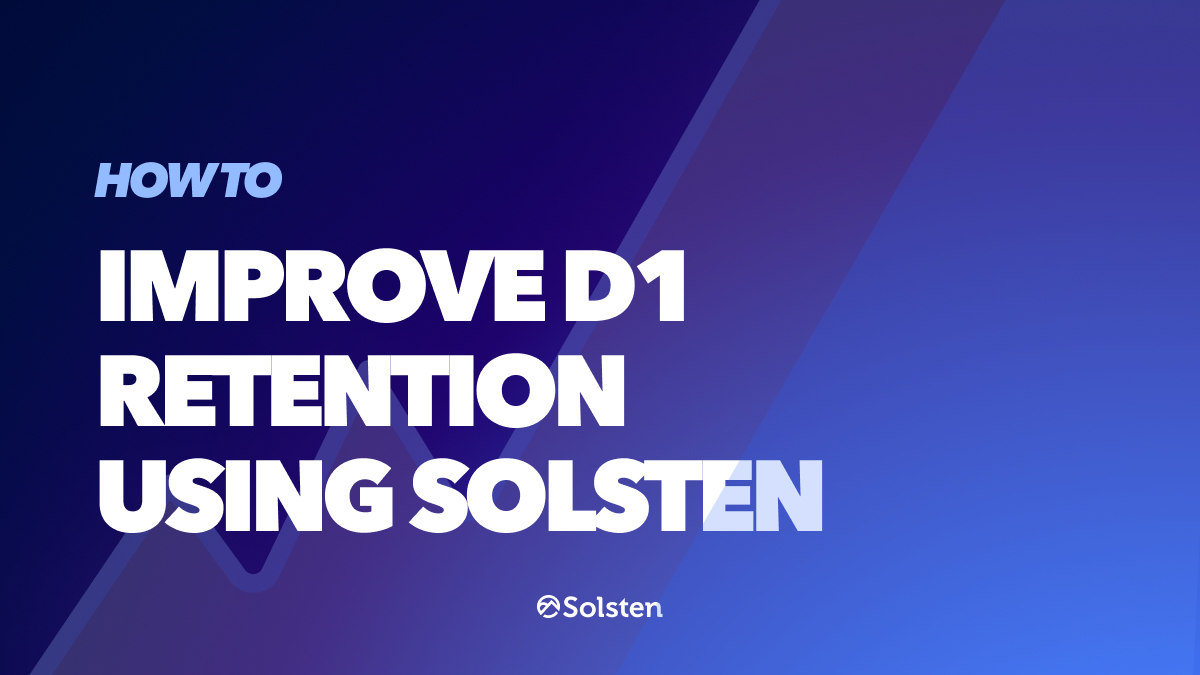Day one (D1) retention is one of the most important metrics in game development. Acting as an early indicator of a game’s ability to captivate players right from the first interaction, it lays the foundation for long-term player retention and a game’s overall success. Players who have a positive experience on their first day are more likely to remain engaged over time.
A low D1 retention rate is a huge red flag. It signals potential issues in the game’s design or user experience. This can lead to a significant drop-off in players, impacting the game’s sustainability and profitability. While D1 retention isn’t the most important for every game or genre, it is for most mobile and free to play games.
Solsten presents a revolutionary approach to improving D1 retention. Our software provides game developers with in-depth insights into player psychology, preferences, and motivations. For live games, Solsten’s Traits gives you quick access to the psychological data of your actual player base. This makes it easy to do things like improve a first time user experience (FTUE) based .
For games in development, Solsten’s Navigator shows you the wants and needs of your future audience.
This information is vital for crafting a game’s initial content, tutorials, and challenges. It helps developers align this early content with what their players find most engaging. This targeted approach ensures that games are not just played, but thoroughly enjoyed from the first interaction, creating strong D1 retention.
So, how does using Solsten help to improve D1 retention? Let’s explore.
Using Solsten to Improve D1 Retention
Redefine FTUE Creation
D1 retention is where the art of delivering moment-to-moment fun meets the science of player alignment and acquisition. Solsten empowers you to craft an FTUE that is not just engaging but also intuitive and personalized.
The FTUE is your game’s onboarding experience. Using Solsten’s player insights, you can fine-tune this experience so that it speaks directly to your players’ preferred gaming styles. For instance, if data indicates a player segment enjoys exploration, you might introduce an open-world element early in the game. For those who appreciate direct competition, incorporating an early multiplayer or competitive feature could be key.
Tailoring the FTUE to player motivations and learning styles can significantly impact their initial impression. It improves the odds of players returning to your game, and is where most games can take the first step to improve player retention.
Break Out of the Trial and Error Loop
Game developers are well aware that a compelling FTUE is crucial for D1 retention. But diagnosing early player engagement issues with in-game behavioral data can feel like chasing phantoms. It’s a continuous loop of trial and error that burns both time and money — and in many cases, turns development costs into a very expensive research budget.
Persisting in this loop can have severe consequences. Your game risks being one of the thousands that tumble into oblivion, unable to sustain itself since it can’t retain players. Months can go by in search of elusive solutions. Without an unlimited runway, that can be all it takes for a game to fail.
The Case of Voodoo Games and Plantopia
This is the position Voodoo Games found themselves in when they were testing Plantopia, a card-based strategy game. Players weren’t sticking around after day one, and Plantopia was in a make-or-break position with a small window of time to fix the problem.
Rather than resorting to cycles of playtesting and iterating to find out what would work, they turned to a groundbreaking alternative that is reshaping the gaming industry — player psychology.
This data, which they accessed on demand in their Solsten Traits dashboard, allowed them to clearly understand the motivations, values, communication styles, hopes, and aspirations of their players.
Based on these insights, the Voodoo team quickly reshaped their FTUE to foster a sense of progression and productivity earlier in the game, so players would feel a sense of empowerment and accomplishment rather than dropping off. When they re-tested Plantopia among their audience, D1 retention jumped a massive 14 percent.
Figuring this out with playtesting and behavioral data analysis would have take months. With Solsten, the answers were in the data, ready to take action with.
Personalize Player Experiences
By leveraging player psychology data, Solsten can enable game developers to create highly personalized gaming experiences. This personalization can range from customizing in-game content and challenges to tailoring tutorials and early game missions, ensuring they resonate with the preferences and styles of different player segments.
Community Engagement Insights
Understanding the social and community aspects that resonate with players can be pivotal in D1 retention. Solsten offers insights into the types of social interactions or community features that players find appealing, aiding in the design of social mechanics and community engagement strategies from the outset.
Optimize User Acquisition Strategies
Solsten provides valuable insights into the types of players most likely to enjoy and engage with a game. This information can be used to optimize user acquisition strategies, ensuring that marketing efforts are targeted towards acquiring players with the highest potential for strong D1 retention.
The Power of Marketing in Enhancing D1 Retention
Another crucial aspect of D1 retention is market to game audience fit. Solsten worked with a game company that had an exceptionally high-performing ad optimized for players with high empathy levels. Using the audience insights provided by Solsten’s Navigator, the marketing team knew that the highest LTV group in their specific market (a casual game) ranked above the 90th percentile in empathy.
Solsten knows that highly empathetic people are more drawn to creative materials with numerous facial expressions. This attracts the ideal market potential audience from the start.
By using their Traits dashboard to measure the players in their game, and Navigator to understand the broader market, the company realized that they were indeed acquiring the ideal players on D0. However, they were struggling with retention. The FTUE lacked facial expressions and failed to cater to individuals with high empathy in any way.
In this case, the marketing and product teams did not work closely together, creating a broken FTUE. Aligning the marketing and FTUE funnels to cater to the ideal player psychology, using Traits and Navigator, is one of the most effective ways to ensure not only high levels of D1 retention, but high levels of D1 retention within the largest market potential audience in a game.
Onward to D7
D1 retention is critical because it sets a game’s audience ceiling. The higher your D1 retention can be, the higher your potential numbers for long-term retention are. But as critical as this retention metric is, for a game with long-term aspirations, it is truly just the tip of the iceberg. In subsequent days, players will decide whether your game was a novelty, or whether they’re willing to invest their time and money in your experience.



